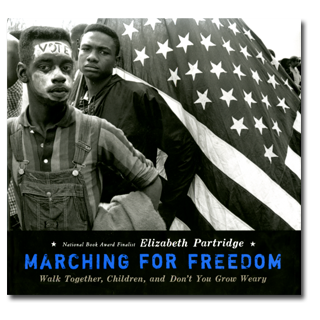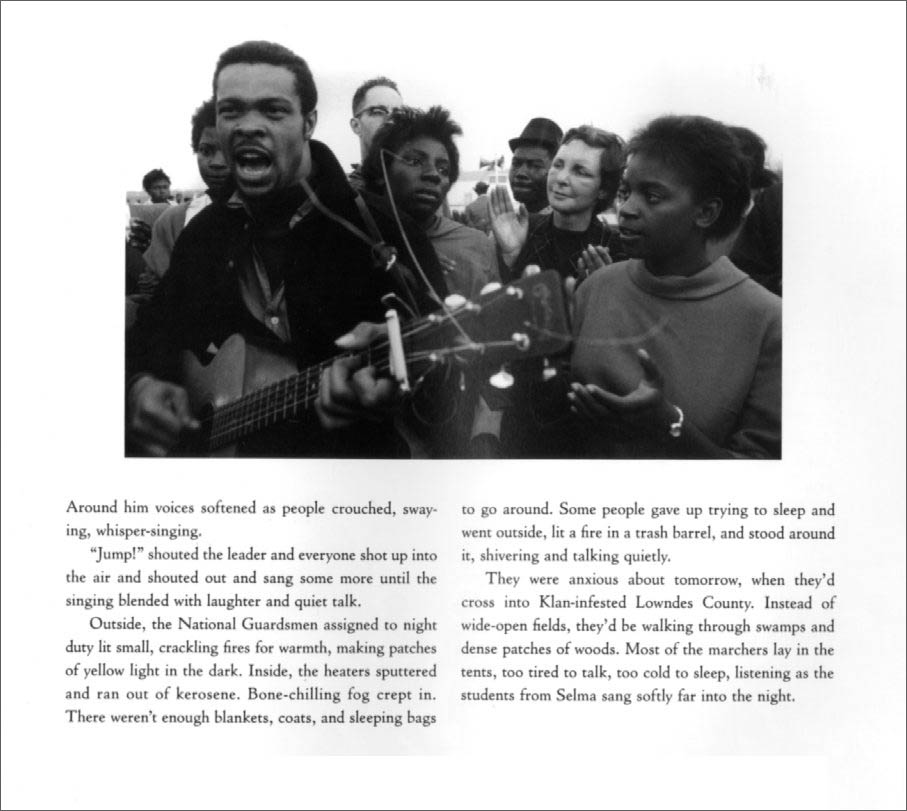
A FEW OTHER EVENTS FOR
MARCH 21:
- Happy birthday Margaret Mahy (Bubble Trouble), Michael Foreman (War Game), Peter Catalanotto (Ivan the Terrier), and Lisa Desimini (How the Stars Fell into the Sky: A Navajo Legend).
- It’s the birth date of Phyllis McGinley (1905–1978) The Year without a Santa Claus, and David Wisniewski (1953–2002), Golem.
- The first United States zoo! In 1859, the charter estabilishing the Zoological Society of Philadelphia was approved and signed. Read The Trumpet of the Swan by E. B. White.
- On this day in 1928, Charles Lindbergh was presented with Medal of Honor, the highest accolade a United States Citizen can receive, in acknowledgment of his trans-Atlantic flight of 1927. Read Charles A. Lindbergh: A Human Hero by James Cross Giblin.
On March 21, 1965, Dr. Martin Luther King Jr. began the five-day protest march from Selma to Montgomery, Alabama—a triumphant event in the Civil Rights Movement. A few months later the Voting Rights Act was signed into law, outlawing literacy tests and other measures used to keep African Americans from registering to vote.
A remarkable book came out in 2009, Marching for Freedom: Walk Together, Children, and Don’t You Grow Weary by Elizabeth Partridge, which explores in vivid detail the eight tumultuous months in 1965 that ended with the Voting Rights Act. On January 2 Dr. Martin Luther King Jr. spoke at the Brown Chapel African Methodist Episcopal Church in Selma: “We’re not on our knees begging for the ballot. We are demanding the ballot.” On March 7, Bloody Sunday, troopers turned tear gas and billy clubs on peaceful marchers. By the time readers come to the events of March 21, they completely understand what is at stake—and just how brutal the fight for voting rights was.
Partridge tells this story through the eyes of the children and young adults who experienced the events. The book begins with the first arrest of a ten-year-old Joanne Blackmon, who goes with her grandmother as she tries to register to vote. In photographs and personal stories, Partridge puts a human face on the events of 1965. Although the freedom fighters know they can be beaten, even killed, they persist. In a calm, even voice Partridge lays out the events and issues, using stunning photographs, many rarely seen, along with freedom songs and chants, to round out the presentation.
Powerful, inspiring, and moving, the book not only presents information but also raises ethical questions. How could American citizens be denied their rights? How could white officials and the Klu Klux Klan be allowed to spread fear and violence in these communities?Â
A perfect book for family or classroom discussion, Marching for Freedom also reminds adults and children that young people can challenge their society and change laws. Partridge ends the saga with these words, “Hundreds of students put themselves a risk to change American voting laws…With only their songs and faith for protection, they believed they could make a difference. And they did.”
Here’s a page from Marching for Freedom:
Originally posted March 21, 2011. Updated for .







I am always excited to find books like this one, that provide a fresh lens with which to examine a part of history, particularly something so widely read about in schools as the Civil Rights Movement. Yet Partridge, through her argument that none of this could have been achieved without the young people, definitely gives new insight into well-trodden history, and I think particularly causes the reader to see MLK in a slightly new light. Hoose’s Claudette Colvin also did this, as does Susan Bartoletti’s new KKK book.
Just read Partridge’s acceptance speech in the Jan/Feb 2011 Horn Book issue, and it’s great, as well!
I absolutely loved this book. After reading it in a library, I decided to buy a copy to put on my shelf! One reason I think this book works so well, besides seeing the story through the eyes of children who experienced it, were the photographs. The pictures really drew me in and brought history to life.
For me, the best thing about this book–besides the stories from the youth’s point of view–are the photos. I felt like I was flipping through a photo journal. The photos really placed the reader into the march. It was very moving and powerful.
This is an enthralling portrait of an important time in American History. Once I started reading it, I couldn’t put it down, which is more than I can say about my memories of reading history textbooks in school. The emotion in the photographs give the book a quality of realness and truth that is vital in creating a connection with readers.
This is the era that stirs something inside of me. The photography is compelling and powerful!!
Such an amazing, incredibly powerful book. It seems that children’s and YA nonfiction writers are taking more risks and choosing more complicated topics and I am so excited to see where this genre goes in the next few years.
This book was such a shocking read but in the best possible way! It was fascinating to actually see some of the events of this era, rather than just read about them. Thank you, Elizabeth Partridge, for assembling this book. It’s a new way for people (students and young teachers like me) to look at a complicated time in US history and experience it in a new way!
I don’t know if I can adequately describe how wonderful I think this book is. I was involved in activism and community work from a very early age, and hearing the stories of other youth working to bring about change has always inspired me to work harder towards my goals, and to believe that my efforts can actually make a difference. When I read this book, I cried. The courage of these youth, the impact they had, the incredible photographs that document their struggle, are astounding. This is a book I now refer to for inspiration on a regular basis as I write about youth activism. It is a reminder of why the stories of youth are so important to tell, and how wonderfully they can be presented. I cannot recommend this book enough.
This book strikes a chord within me because it reminds me of my parents and the stories they told me about growing up during the Civil Rights movement. Being told about it over the dinnert table or at bedtime, they seemed like stories with clearly delineated heroes and villains, plotpoints and ultimately a happy ending. This book shatters that fairytale and gives a viceral realistic depitcion of the events and the players, many of whom are not the names we read about in grade school or middle school American History. These people were ordinary fathers and mothers, husbands, wives, and children drawn into an epic struggle. These photos capture that beautifully in the most authentic disturbing manner possible.